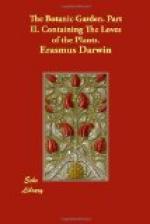Maid of night Fairies—Electric lady—Shadrec, Meshec, and Abednego, in the fiery furnace—Shepherdesses—Song to Echo—Kingdom of China—Lady and distaff—Cupid spinning—Lady walking in snow—Children at play—Venus and Loves—Matlock Bath—Angel bathing—Mermaid and Nereids—Lady in salt— Lot’s wife—Lady in regimentals—Dejanira in a lion’s skin—Offspring from the marriage of the Rose and Nightingale—Parched deserts in Africa— Turkish lady in an undress—Ice-scene in Lapland—Lock-lomond by moon light—Hero and Leander—Gnome-husband and Palace under ground—Lady inclosed in a fig—Sylph-husband—Marine cave—Proteus-lover—Lady on a Dolphin—Lady bridling a Pard—Lady saluted by a Swan—Hymeneal procession —Night
CONTENTS OF THE NOTES.
* * * * *
Seeds of Canna used for prayer-beads
Stems and leaves of Callitriche so matted together, as they float on the water, as to bear a person walking on them
The female in Collinsonia approaches first to one of the males, and then to the other
Females in Nigella and Epilobium bend towards the males for some days, and then leave them
The stigma or head of the female in Spartium (common broom) is produced amongst the higher set of males; but when the keal-leaf opens, the pistil suddenly twists round like a French-horn, and places the stigma amidst the lower set of males
The two lower males in Ballota become mature before the two higher; and, when their dust is shed, turn outwards from the female
The plants of the class Two Powers with naked seeds are all aromatic
Of these Marum and Nepeta are delightful to cats
The filaments in Meadia, Borago, Cyclamen, Solanum, &c. shewn by reasoning to be the most unchangeable parts of those flowers
Rudiments of two hinder wings are seen in the class Diptera, or two-winged insects
Teats of male animals
Filaments without anthers in Curcuma, Linum, &c. and styles without stigmas in many plants, shew the advance of the works of nature towards greater perfection
Double flowers, or vegetable monsters, how produced
The calyx and lower series of petals not changed in double flowers
Dispersion of the dust in nettles and other plants
Cedar and Cypress unperishable
Anthoxanthum gives the fragrant scent to hay
Viviparous plants: the Aphis is viviparous in summer, and oviparous in autumn
Irritability of the stamen of the plants of the class
Syngenesia, or
Confederate males
Some of the males in Lychnis, and other flowers arrive sooner at their maturity
Males approach the female in Gloriosa, Fritillaria, and Kalmia
Contrivances to destroy insects in Silene, Dionaea muscipula, Arum muscivorum, Dypsacus, &c.




